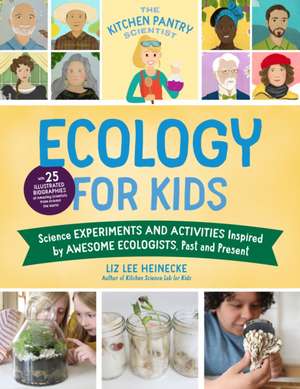The Kitchen Pantry Scientist Ecology for Kids: The Kitchen Pantry Scientist
Autor Liz Lee Heinecke Ilustrat de Kelly Anne Daltonen Limba Engleză Paperback – 9 mar 2023
Preț: 85.47 lei
Preț vechi: 98.46 lei
-13% Nou
16.35€ • 17.12$ • 13.61£
Carte disponibilă
Livrare economică 10-24 martie
Livrare express 21-27 februarie pentru 48.18 lei
Specificații
ISBN-10: 0760375690
Pagini: 128
Ilustrații: 175+ photos and illustrations
Dimensiuni: 214 x 276 x 10 mm
Greutate: 0.61 kg
Editura: Quarto Publishing Group USA, Inc.
Seria The Kitchen Pantry Scientist
Notă biografică
Kelly Anne Dalton is a professional artist and illustrator living in the wild mountains of Montana. Working from her charming 1920s studio, Kelly Anne loves creating a wide range of work, from children's books to decorative greeting cards and gifts. Growing up with a biologist mother, Kelly has had an appreciation for science and nature her entire life, and because of that, she enjoys creating the portraits for the Kitchen Pantry Scientist series. When not drawing, Kelly Anne can be found trail running in the forest, playing with her dogs, and adventuring with her husband.
Cuprins
Lab 1 Alexander Von Humboldt (1769-1778) German: Use blue ice cubes to see how cold water moves in ocean currents.
Lab 2 Eunice Newton Foote (b.1819-1888) American: Do a greenhouse gas experiment in a bottle to see how carbon dioxides traps heat.
Lab 3 Jean Henri Fabre (b.1823) French: Build an insect habitat to study insect behavior and habitat requirements.
Lab 4 William Emerson Ritter (1856-1944) American: Capture invertebrates in pitfall traps, soil sieves and aquatic sieves to study population diversity.
Lab 5 Eugenius Warming (1841-1924) Danish: Make a paper cactus with accordion folds to see how cacti expand when it rains.
Lab 6 George Washington Carver (b.1864) American: Grow beans to see how different soil conditions affect growth.
Lab 7 Ed Ricketts (1897-1948) American: Build a tide pool in a tub and make waves to learn about shoreline invertebrates.
Lab 8 G. Evelyn Hutchinson (1903-1991) English: Build a diorama of an ecosystem to illustrate niches occupied by different animals.
Lab 9 Dora P Henry (1904-1999) American: Use bottle caps, yarn and frosting to study the life cycle of barnacles and learn how they attach to rocks, boats and whales.
Lab 10 Rachel Carson (b.1907) American: Make a Secchi disk to test water clarity and take water samples from a local pond, lake or stream.
Lab 11 Eugene Odum (1924-2002) American: Rope off a biodiversity square and see how many plant and animal species you can find.
Lab 12 Akira Miyawaki (1928-2021) Japanese; Plant chia seeds on a slope to see how trees protect soil from wind and water erosion.
Lab 13 E. O. Wilson (1929-2021) American: Make a sweep net to capture and study invertebrates. Observe insects in their natural habitats.
Lab 14 Sylvia Alice Earle (b.1930) American: Create an oil spill in a bowl and experiment to see which materials remove oil from the water.
Lab 15 O'Neil Ray Collins (1931) American: Dissect a mushroom and make prints from the spores.
Lab 16 C.S. Holling (1930-2019) Canadian: Search for animal footprint and make casts of them. Identify the animals as predator or prey.
Lab 17 Wanari Maathai (b.1940) Kenyan: Germinate beans or tree seeds in a jar and transplant the seedlings.
Lab 18 Robin Wall Kimmer (b. 1953) American: Observe and collect moss/ look for tardigrades
Lab 19 Rodrigo Medellin (b.1957) Mexican: Do an echolocation experiment to illustrate how bats locate their prey.
Lab 20 Dana Bergstrom (b.1962) Australian: Use water, your breath and a stuffed animal to see how seeds are dispersed by ocean, wind and animals.
Lab 21 Aparajita Datta (b.1970) Indian: Observe insects such as butterflies, caterpillars, bees, aphids and beetles to learn about the relationship between plants and animals.
Lab 22 Lisa Schulte Moore American: Make prairie plants from chenille sticks to see how long roots reach for water and prevent soil erosion.
Lab 23 Lesley de Souza (b.1977) Brazilian/American: Build a rainforest terrarium or an aquatic ecosystem.
Lab 24 Ayana Elizabeth Johnson (b.1980) American: Use carbonated water and red cabbage juice to see how carbon dioxide acidifies ocean water.
Lab 25 Jodie Darquea Arteaga ( ) Ecuadorian: Make a fishing net from a produce bag and use candy fish to see how dolphins, turtles can be entangled.
Descriere
Aspiring young ecologists will discover an amazing group of role models and memorable experiments in Ecology for Kids, the fifth book in The Kitchen Pantry Scientist series.
This engaging guide offers a series of snapshots of 25 scientists famous for their work with ecology. Each lab tells the story of a scientist along with some background about the importance of their work, and a description of where it is still being used or reflected in today’s world.
A step-by-step illustrated experiment paired with each story offers kids a hands-on opportunity for exploring concepts the scientists pursued, or are working on today. Experiments range from very simple projects using materials you probably already have on hand, to more complicated ones that may require a few inexpensive items you can purchase online. Just a few of the incredible people and scientific concepts you’ll explore:
Eunice Newton Foote (b. 1819)
See how carbon dioxides trap heat
George Washington Carver (b. 1864)
Grow beans and study soil conditions
Rachel Carson (b. 1907)
Test the water clarity from local ponds, lakes, or steams
E. O. Wilson (b. 1929)
Observe insects in their natural habitats
With this fascinating, hands-on exploration of the history of ecology, inspire the next generation of great scientists.
Dig into even more incredible science history from The Kitchen Pantry Scientist series with: Chemistry for Kids, Biology for Kids, Physics for Kids, and Math for Kids.




